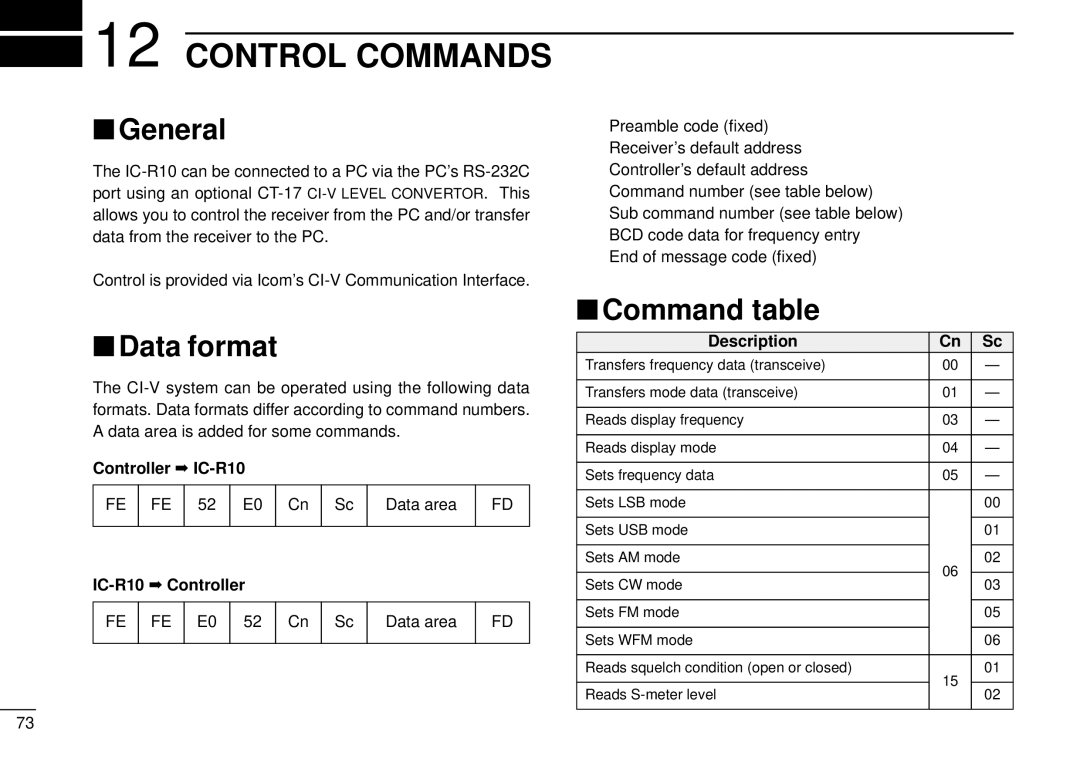IR10
Read ALL Instructions Carefully be
Fore attempting to operate the receiver
Following explicit definitions apply to this manual
Q1 Antenna W1 Handstrap
Accessories included with the receiver
For U.S.A. only
T1 Ni-Cd batteries
Table of Contents
Operating Theory
Panel Description
Front and side panels
Emits the receive audio
Varies the squelch threshold point for audio mute
Adjusts the audio output level
Top panel
Varies the RF gain in LSB, USB and CW modes
Memo VFO Easy VSC AT T
Function display
Appears while in memory mode p
Appears while the sleep timer is activated p
Appears while the function Func switch is pushed
Appears while in VFO mode p
Keypad
Secondary Function while pushing Func
Memory search function p
Secondary Function while pushing Func
Charging precautions
Charging Ni-Cd batteries
About Ni-Cd batteries
Battery installation
Charging connections
Belt clip
Accessory attachment
Antenna
Handstrap
Adjust the volume
Selecting VFO mode
Turn power on
Basic Operation
Select VFO mode
Adjust the squelch
Adjust the RF gain
What is squelch?
Selecting a receive mode
What are receive modes?
Select the tuning step
Selecting a tuning step
Call up the tuning step set mode
What are tuning steps?
Tuning a frequency via the keypad
Select the frequency
Enter the frequency
Tune a frequency
Tuning a frequency via the dial
Select VFO mode and a receive mode
Rotate Dial to change the fre- quency
Dial select steps
What are dial select steps?
Push and hold FUNC, then rotate Dial
What is the band scope function?
Band scope function
Preparation
Set band scope function
While pushing FUNC, push 1BSCOPE
Select the receive mode
Adjust volume
Adjust squelch
Select VFO
Example 59.25 MHz
Use the tuning dial
Example 59.75 MHz
Tune the station
Listening example 2 airband broadcast in AM mode
Enter a frequency of 118.0000 MHz* using the keypad p
Example 118.00 MHz Example 118.925 MHz
Select Memory mode
Memory Mode
Selecting Memory mode
What is memory mode?
Selecting a memory channel-1
Selecting a Bank and memory channel
Selecting a Bank channel
Selecting a memory channel-2
Programming a memory channel
Bank and memory channel setting
Setting other information
Programming
Setting receive conditions
Select VFO mode p Set the frequency and receive mode p
While pushing FUNC, push V/MMW
Set up
Programming details
Programming details
Push 0 and 7 to enter the mem- ory channel number
Data setting
Programming the data
While pushing FUNC, push V/MMW for 2 sec
Set the Bank and memory channel
Setting the frequency
1While pushing FUNC, push V/MMW to enter memory write mode
Push
Push Edit to enter memory set- ting mode
Rotate Dial or push 0 then 1 to select channel
Programming details Cont
Modeam
Memory copy
Copy to VFO mode
What is the memory copy function?
Copy to the other memory channel
Copying example
59.7500 MHz, WFM, A45 to VFO
What is scanning?
Scanning Operation
Repeatedly scans operatable frequency range
A01 A03 A04
A00 FM only A05 B00-R99 A07 A06
Set receive mode
Set the volume and squelch levels
Before scanning
What is scan delay?
Set the scan delay
What is VSC?
Set the VSC
Full scan
Memory scan
Start and stop the scan
Program scan
Start and stop scanning
Select program scan channel
Auto memory write scan
During auto-memory write scanning
For your convenience
Bank scan
Select Bank scan and Bank number
While pushing FUNC, push 8BANK-S
Mode select scan
Select mode select scan and mode
Memory skip setting
Program skip setting
Program skip setting Cont
Skip function
Select scan type and start scanning
Signavi function
Set Signavi function
3Push Scan or CLR to stop scan- ning
What is priority watch?
Priority Watch
Types of priority watch
A01A32
Set Main frequency
Into Priority Channel VFO Mode p or Memory mode p
Program a priority channel
You want to program
Select Easy mode
Easy Mode
Easy mode operation
Push Easy to select Easy mode Appears
Memory channel edit
Attenuator settings can be toggled on or OFF
Edit Function
You can store the following items into a memory channel
Memory channel edit flow chart
A00
Set channel names
Enter memory edit mode
Set frequency
Enter channel Names via Keypad or by ro Tating Dial
Set attenuator condition
Set receive mode and skip condition
Rotate Dial to select receive mode
Set Bank names
Program scan channel edit
Easy mode channel edit
Select or program a tuning step
Set the start frequency for scan frequency range
Start Freq
Program scan or Easy mode channel edit
Enter edit mode
Set start frequency
Rotate Dial to select scan delay time
Set receive mode and tuning step
Set scan delay time
Push and hold Edit to enter the set contents
SET Mode
What is SET mode?
Beep audio
Entering SET mode
Opening message
Display contrast
Program skip
Power save
Backlight Condition
Memory skip
CI-V baud
Scan delay
CI-V address
CI-V transceive
Low battery indicator activates when the installed batter
Low battery indicator
Setting AFC
Other Functions
Set monitor
Monitor function
Lock function
Set lock
Set ATT
ATT function
NB/ANL function
Set NB/ANL
Set sleep timer
Sleep timer function
User TS setting
Set tuning step
Enter memory channel names
Enter memory search mode
Memory search function
Enter memory channel names via the keypad or Dial
Push Scan to start memory channel search
Searching
Selecting a memory channel
Push ENT to select a memory channel
Auto mode and TS function
Set auto mode
Set auto TS
Resetting the CPU
Partial reset
All reset
Set cloning mode and start cloning
Data cloning
Connect an optional OPC-474 be Tween both SP jacks
Alphanumeric KEY Assignment
Alphanumeric input
Data format
Control Commands
Command table
Data area
Power supply 15VDC Computer Optional
RS-232C Cable
To CI-V
Troubleshooting
Problem Possible Cause Solution
Troubleshooting
Specifications
General
Options
Protects the receiver from everyday wear and tear
Allows you to transfer data between receivers
Kamihigashi, Hirano-ku, Osaka 547 Japan
